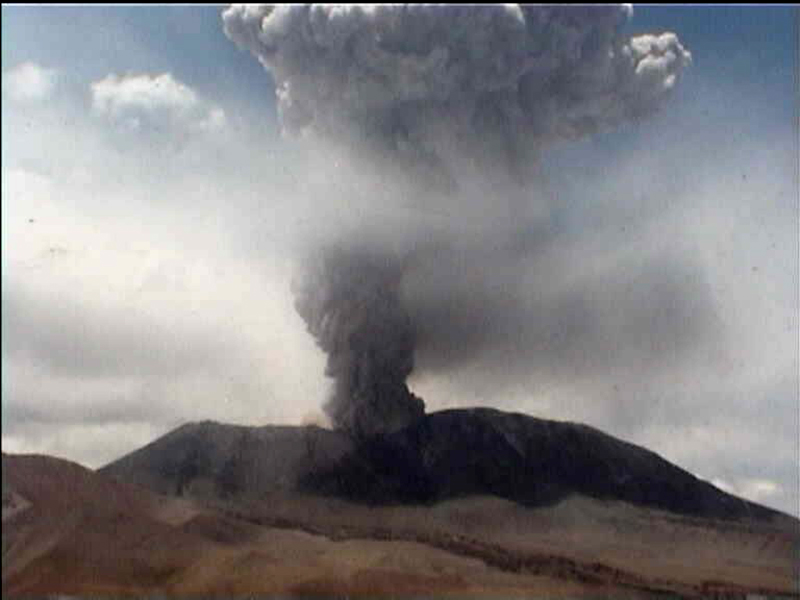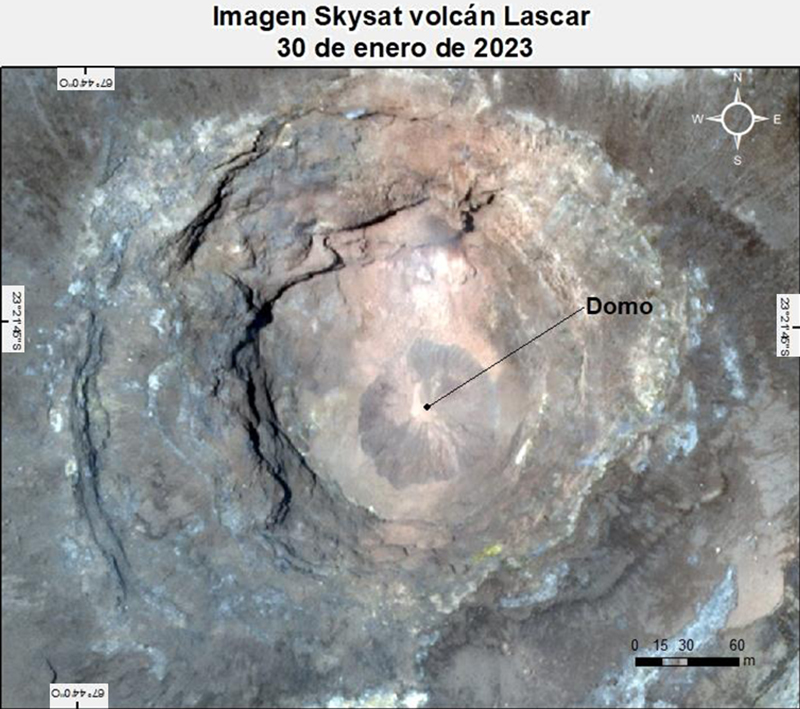Report on Lascar (Chile) — March 2023
Bulletin of the Global Volcanism Network, vol. 48, no. 3 (March 2023)
Managing Editor: Edward Venzke.
Edited by Kadie L. Bennis.
Lascar (Chile) New effusive dome, ash plumes, and crater incandescence during December 2022-February 2023
Please cite this report as:
Global Volcanism Program, 2023. Report on Lascar (Chile) (Bennis, K.L., and Venzke, E., eds.). Bulletin of the Global Volcanism Network, 48:3. Smithsonian Institution.
Lascar
Chile
23.37°S, 67.73°W; summit elev. 5592 m
All times are local (unless otherwise noted)
Láscar, located in the northern Chilean Andes, contains six overlapping summit craters and two major edifices; activity began at the eastern volcano and then shifted to the western cone. Frequent small-to-moderate explosive eruptions have been recorded since the mid-19th century, in addition to periodic larger eruptions that produced ashfall hundreds of kilometers away. The previous eruption during October 2015-April 2017 was characterized by ash plumes, thermal activity, and gas-and-steam emissions. This report covers a new eruption that included an explosion, ash plumes, and thermal activity during December 2022 through February 2023 using information from Chile's Servicio Nacional de Geología y Minería, (SERNAGEOMIN).
Typical activity prior to December 2022 consisted of seismicity, sulfur dioxide emissions, and occasional thermal anomalies. Seismicity during December was characterized by 62 volcano-tectonic (VT)-type events associated with rock fracturing, 165 long period (LP)-type events, and 16 tremor (TR)-type events. Sulfur dioxide emissions data was obtained by the Differential Optical Absorption Spectroscopy (DOAS) equipment located 6 km ESE from the active crater. The average value was 285 ± 46 t/d during 1-15 December and 612 ± 67 t/d during 16-31 December, with a maximum daily value of 1,333 t/d on 26 December. On 10 December an explosion was detected on the N slope of the volcano at 1236 that produced an ash plume that rose 6 km above the crater and drifted SW (figure 47), based on GOES satellite images. Additionally, pyroclastic flows generated near the crater following this event traveled N and SE. Gas-and-steam emissions rose 20-880 m above the crater, accompanied by intermittent nighttime incandescence that was visible 640 m above the crater. A thin layer of ash was deposited to the S, SW, W, and NW. After this explosive event, seismicity gradually declined. On 18 December white gas-and-steam emissions were observed up to 980 m above the crater and nighttime crater incandescence was observed during 25-27 December. SERNAGEOMIN reported that after 19 December activity levels returned to baseline.
Seismicity during January 2023 consisted of 22 VT-type events and 23 LP-type events. Sulfur dioxide emissions data obtained by the DOAS equipment had an average value of 483 ± 74 t/d, with a maximum daily value of 881 t/d on 13 January. Occasional low-level thermal anomalies were detected in satellite images, corresponding to passive degassing from the vents in the summit crater. More frequent and robust gas-and-steam emissions were reported during January compared to previous months, rising as high as 1.4 km above the crater. Starting on 11 January low intensity nighttime incandescence was occasionally observed. A total of 14 thermal anomalies were detected in satellite data during 13-28 January; the intensity of the anomalies increased on 17 January and peaked on 22 January. On 18 January sulfur dioxide emissions had a peak average value of 1,787 t/d. According to SERNAGEOMIN, a low-energy eruptive pulse was detected on 26 January at 2259, which corresponded to incandescent ejecta and an emission plume that likely contained tephra, rising almost 1.9 km above the crater and drifting NW. On 27 January at 2300 the intensity of LP events significantly increased, and crater incandescence was detected. A series of four LP events were recorded at 0015, 0032, 0043, and 0052 on 28 January, which corresponded with emissions that rose 380 m above the crater rim and drifted NW. Minor crater incandescence persisted and gas-and-steam plumes rose as high as 760 m above the crater. Elevated levels of seismicity continued during 28-30 January.
A Skysat image taken on 30 January showed a shallow, effusive, dome-like body that covered 5.3 m2 in the active crater (figure 48). On 31 January the effusive body was measured and had a diameter of 81 m along the minor axis and 93 m along the major axis. By 2 February the dome-like body had grown to cover an area of 6.2 m2 in the active crater, which suggested a growth rate of 308 m2 per day. A low-level reddish gas-and-steam emission rose 200-340 m above the crater rim and drifted SW at 2053 on 4 February. Mostly diffuse gas-and-steam emissions continued throughout the month, generally rising 400-500 m above the crater rim, though during 11-12 February emissions rose as high as 700 m above the crater rim. The average value of sulfur dioxide emissions was 443 t/d measured on 17 February using DOAS equipment and on 20 and 21 February the average value was 21 t/d and 460 t/d, respectively.
Geological Summary. Láscar is the most active volcano of the northern Chilean Andes. The andesitic-to-dacitic stratovolcano contains six overlapping summit craters. Prominent lava flows descend its NW flanks. An older, higher stratovolcano 5 km E, Volcán Aguas Calientes, displays a well-developed summit crater and a probable Holocene lava flow near its summit (de Silva and Francis, 1991). Láscar consists of two major edifices; activity began at the eastern volcano and then shifted to the western cone. The largest eruption took place about 26,500 years ago, and following the eruption of the Tumbres scoria flow about 9000 years ago, activity shifted back to the eastern edifice, where three overlapping craters were formed. Frequent small-to-moderate explosive eruptions have been recorded since the mid-19th century, along with periodic larger eruptions that produced ashfall hundreds of kilometers away. The largest historical eruption took place in 1993, producing pyroclastic flows to 8.5 km NW of the summit and ashfall in Buenos Aires.
Information Contacts: Servicio Nacional de Geología y Minería, (SERNAGEOMIN), Observatorio Volcanológico de Los Andes del Sur (OVDAS), Avda Sta María No. 0104, Santiago, Chile (URL: http://www.sernageomin.cl/).



